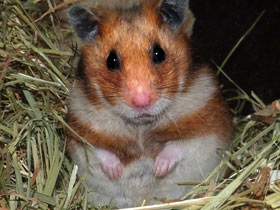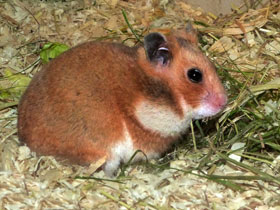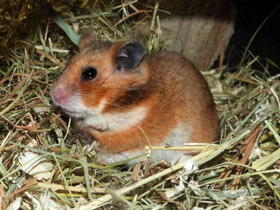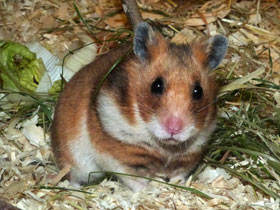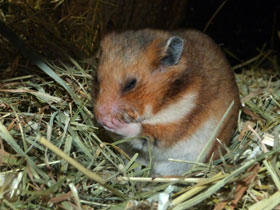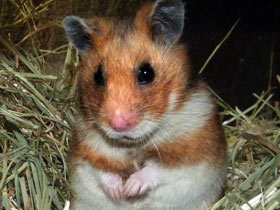The golden hamster or Syrian hamster (Mesocricetus auratus)
The golden hamster or Syrian hamster (Mesocricetus auratus) is a rodent belonging to the hamster subfamily, Cricetinae.
Mesocricetus auratus are covered with soft, dense fur of golden, white, black, silver or brown colours. Their body length is 13-13.5 centimetres, of which about 1.5 centimetres is the tail. The weight is up to 100-125 grams. Like most members of this family, Mesocricetus auratus has expanding cheek pouches that extend from the cheeks to the animal's shoulders. In the wild, hamsters use the cheek pouches to transport food to their burrows. The hamster's name in the local Arabic dialect, roughly translates to "lord of the saddlebags" (Arabic أبو جراب) because of the capacity of its cheek pouches. If food is plentiful, the hamster stores it for a long time before eating it.
Sexually mature females of Mesocricetus auratus enter the season (heat) every four days. The gestation period of the golden hamster is about 16 days. The average size of the animal's litter is between eight and ten cubs, but can reach up to twenty. If the mother hamster is inexperienced or threatened, she may abandon her offspring, or eat them. Almost immediately after giving birth, the female goes into heat, during which she may become pregnant again.
Discovery
Golden hamsters originate from Syria and were first described by science in the 1797 second edition of The Natural History of Aleppo, a book written and edited by two Scottish physicians living in Syria. The Syrian hamster was then recognized as a distinct species in 1839 by British zoologist George Robert Waterhouse, who named it Cricetus auratus or the "golden hamster". The skin of the holotype specimen is kept at the Natural History Museum in London.
In 1930, Israel Aharoni, a zoologist and professor at the Hebrew University of Jerusalem, captured a mother hamster and her litter of pups in Aleppo, Syria. The hamsters were bred in Jerusalem as laboratory animals.
Descendants of the captive hamsters were shipped to Britain in 1931, where they came under the care of the Wellcome Bureau of Scientific Research. These bred and two more pairs were given to the Zoological Society of London in 1932. The descendants of these were passed on to private breeders in 1937. A separate stock of hamsters was exported from Syria to the United States in 1971, but mitochondrial DNA studies have established that all domestic golden hamsters are descended from one female – likely the one captured in 1930 in Syria.
Since the species was named, the genus Cricetus has been subdivided and this species (together with several others) was separated into the genus Mesocricetus, leading to the currently accepted scientific name for the golden hamster of Mesocricetus auratus.
As research animals
Golden hamsters are used to model human medical conditions including various cancers, metabolic diseases, non-cancer respiratory diseases, cardiovascular diseases, infectious diseases, and general health concerns. In 2006 and 2007, golden hamsters accounted for 19% of the total Animal Welfare Act-covered animal research subjects in the United States.
As pets
Golden hamsters are popular as house pets due to their docile, inquisitive nature, cuteness, and small size. However, these animals have some special requirements that must be met for them to be healthy. Although some people think of them as a pet for young children, the American Society for the Prevention of Cruelty to Animals recommends hamsters as pets only for people over age 6 and the child should be supervised by an adult. Cages should be a suitable size, safe, comfortable, and interesting. If a hamster is constantly chewing and/or climbing on the bars of its cage then it needs more stimulation or a larger cage. The minimum recommended size for a hamster cage is 775 square inches (5,000 cm2), of continuous floor space (although the source of this recommendation is unknown). These can be made by cutting and connecting large plastic storage bins, or a large glass tank. Appropriately sized wooden cages can be made, or bought online. The majority of hamster cages sold in pet stores do not meet these size requirements. Hamster Society Singapore (HHS) recommends a minimum of 4,000 square centimetres (620 sq in) for Syrian hamsters, while Tierärztliche Vereinigung für Tierschutz (TVT) recommends giving them as much space as you can and at minimum 100 cm × 50 cm × 50 cm (L × W × H) which is 5,000 cm2 (780 sq in).
A hamster wheel is a common type of environmental enrichment, and it is important that hamsters have a wheel in their cage. TVT recommends wheels should be at least 30 cm for Syrian hamsters, since smaller diameters lead to permanent spinal curvatures, especially in young animals. They also recommend a solid running surface because rungs or mesh can cause injury, or bumblefoot. A hamster should be able to run on its wheel without arching its back. A hamster that has to run with an arched back can have back pain and spine problems. A variety of toys and cardboard tubes and boxes can help to provide enrichment, as they are energetic and need space to exercise.
Most hamsters in American and British pet stores are golden hamsters. Originally, golden hamsters occurred in just one color – the mixture of brown, black, and gold, but they have since developed a variety of color and pattern mutations, including cream, white, blonde, cinnamon, tortoiseshell, black, three different shades of gray, dominant spot, banded, and dilute.
Breed variations
Often long-haired hamsters are referred to by their nickname "teddy bear". They are identical to short-haired Syrians except for the hair length and can be found in any color, pattern, or other coat type available in the species. Male long-haired hamsters usually have longer fur than the female, culminating in a "skirt" of longer fur around their backsides. Long-haired females have a much shorter coat although it is still significantly longer than that of a short-haired female.

















